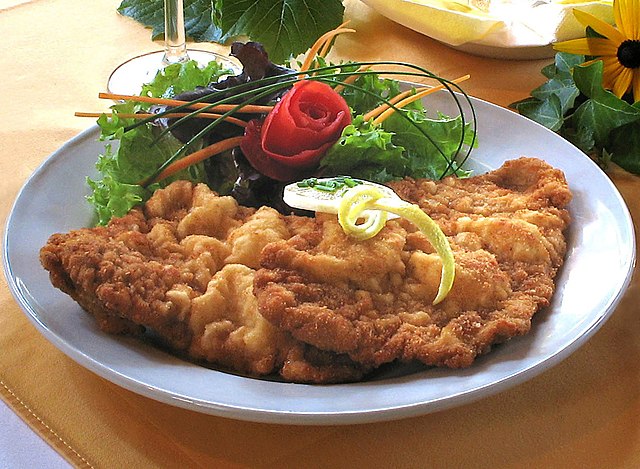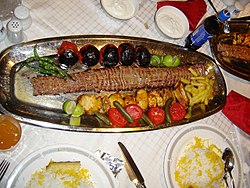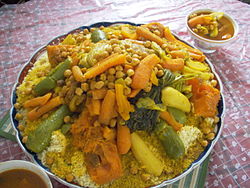Top Qs
Timeline
Chat
Perspective
National dish
Culinary dish strongly associated with a particular country From Wikipedia, the free encyclopedia
Remove ads
A national dish is a culinary dish that is strongly associated with a particular country.[1] A dish can be considered a national dish for a variety of reasons:
- It is a staple food, made from a selection of locally available foodstuffs that can be prepared in a distinctive way, such as fruits de mer, served along the west coast of France.[1]
- It contains a particular ingredient that is produced locally, such as a paprika grown in the European Pyrenees.[1]
- It is served as a festive culinary tradition that forms part of a cultural heritage—for example, barbecues at summer camp or fondue at dinner parties—or as part of a religious practice, such as Korban Pesach or Iftar celebrations.[1]
- It has been promoted as a national dish, by the country itself, such as the promotion of fondue as a national dish of Switzerland by the Swiss Cheese Union (Schweizerische Käseunion) in the 1930s.

National dishes are part of a nation's identity and self-image.[2] For example, pizza is considered one of the national dishes of Italy and its variants are among the most popular foods in the world. During the age of European empire-building, nations would develop a national cuisine to distinguish themselves from their rivals.[3]
Some countries such as Mexico, China or India, because of their diverse ethnic populations, cultures, and cuisines, do not have a single national dish, even unofficially.[2] Furthermore, because national dishes are so interwoven into a nation's sense of identity, strong emotions and conflicts can arise when trying to choose a country's national dish.
Remove ads
By country
Summarize
Perspective
This is not a definitive list of national dishes, but rather a list of some foods that have been suggested to be national dishes.
A


- Afghanistan: kabuli palaw[4]
- Albania: tavë kosi,[5] flia
- Algeria: couscous,[6] rechta
- Andorra: escudella i carn d'olla[7]
- Angola: moamba de galinha[8]
- Antigua and Barbuda: fungee and pepperpot
- Argentina: asado,[9][6] empanada,[10] matambre,[11][12][13] locro[14]
- Armenia: khorovats, harisa[15] (not to be confused with the North African pepper paste harissa)
- Aruba: Keshi yena[16]
- Australia: roast lamb,[17] meat pie,[18][19][20] Vegemite on toast[21]
- Austria: Wiener schnitzel[22]
- Azerbaijan: dolma[15]
B

- Bahamas: crack conch with peas and rice[23]
- Bahrain: kabsa[24][25]
- Bangladesh: rice and fish (particularly ilish)[26]
- Barbados: cou-cou and salt fish[22]
- Belarus: draniki[27]
- Belgium: frites[28] (particularly served with mussels[29][6] or steak[30]), carbonade flamande,[31] waterzooi,[31] chocolate mousse,[32] Belgian waffle[33]
- Belize: rice and beans[34]
- Benin: kuli-kuli
- Bhutan: ema datshi[35]
- Bolivia: salteñas[36]
- Bosnia and Herzegovina: Bosnian pot,[37] ćevapi,[38][39] burek[40]
- Botswana: seswaa[41]
- Brazil: feijoada[42][6]
- Brunei: ambuyat[43][44]
- Bulgaria: Shopska salad,[45] banitsa[46]
- Burkina Faso: riz gras
- Burundi: boko boko[47]
C

- Cambodia: fish amok,[48][49] num banhchok,[50] samlar kako[51][52]
- Cameroon: ndolé[53]
- Canada: poutine,[54][55][56] donair,[57] butter tarts,[58][59] Nanaimo bar, tourtière
- Cape Verde: cachupa
- Central African Republic: cassava
- Chad: boule
- Chile: empanada,[60] pastel de choclo,[61] marraqueta[62][63]
- China: Peking duck,[64] crayfish,[65][66] hot pot, dumpling, malaxiangguo, dim sum,[67] kaolengmian, tanghulu
- Colombia: ajiaco,[68] bandeja paisa[69]
- Comoros: Langouste a la vanille (vanilla lobster)[70]
- Democratic Republic of the Congo: poulet à la moambé[71]
- Republic of the Congo: poulet moambé[71]
- Costa Rica: casado, chifrijo (chicharrón or deep fried seasoned pork pieces served with beans, usually red or black beans), white rice and pico de gallo (it may be served with avocado and/or corn chips), gallo pinto,[6] olla de carne (stewed beef soup with a variety of vegetables).
- Croatia: zagorski štrukli,[6][72] jota,[73] pašticada (Dalmatia)
- Cuba: ropa vieja[74][75]
- Cyprus: souvla,[76] kleftiko,[77][78] trachanás[79]
- Czech Republic: vepřo knedlo zelo (roast pork with dumplings and sauerkraut),[80] svíčková,[81] paštika
D

- Denmark: stegt flæsk,[82][6][83] smørrebrød[84][85][83], flæskesteg
- Djibouti: skoudehkaris
- Dominica: mountain chicken (historical), callaloo[86]
- Dominican Republic: La bandera (rice, beans and meat)[87]
E
F


- Fiji: Fiji kokoda (Fijian ceviche)[98]
- Finland: rye bread,[99] Karelian pie, karjalanpaisti, lohikeitto, joulutorttu
- France: escargot, pot-au-feu,[100][101] beef bourguignon,[102][103] blanquette de veau,[102] steak frites,[102] baguette,[104] cassoulet,[105] cheese,[106] crêpe,[107] crème caramel,[108] croissant, poule au pot (historical),[109] chou à la crème
G
- Gabon: poulet nyembwe[110]
- The Gambia: domoda[111]
- Georgia: khachapuri,[112][113][114] khinkali[115]
- Germany: schweinshaxe, bratwurst, sauerbraten,[116] döner kebab,[117] currywurst,[118] eisbein with sauerkraut[119][120][121]
- Ghana: fufu, jollof rice
- Greece: horiatiki,[122] moussaka,[123] fasolada[124][123] souvlaki,[123] gyros,[123] magiritsa,[123] kokoretsi[123]
- Grenada: oil down[125]
- Guatemala: pepián[126]
- Guinea: poulet yassa
- Guinea-Bissau: caldo de mancarra
- Guyana: pepperpot and chicken curry[127]
H

I


- Iceland: lamb,[128][129][130] hákarl[131][130][6]
- India: Khichdi, Chaat, butter chicken, biryani, Dal, dosa, idli[132][133][134][135]
- Indonesia: nasi goreng,[136][137] tumpeng,[138] satay,[136][137] soto,[136][139] rendang,[136] gado gado[136]
- Iran: abgoosht,[6] chelo kabab,[140] ghormeh sabzi[141] Fesenjan
- Iraq: masgouf,[142] dolma, Iraqi kebab, quzi
- Ireland: soda bread,[143] butter,[144][145] Irish stew
- Israel: falafel (served in pita),[146][147][148][149][150] Israeli salad,[151][152] meorav Yerushalmi,[153] sabich, Ptitim
- Italy: pasta,[154][36] pizza,[155][156] risotto,[157] mozzarella,[158] Parmigiano Reggiano,[159] Italian wine
- Ivory Coast: atcheke[160]
J

K

- Kazakhstan: beshbarmak[169]
- Kenya: ugali with sukuma wiki,[170] githeri,[170] chapati,[170][171] nyama choma[172]
- Kiribati: Palusami
- Korea, North: raengmyŏn,[173] kimchi[174]
- Korea, South: kimchi,[175] bulgogi,[176] bibimbap,[177] jajangmyeon,[178][179] bingsu,[180] tteokbokki
- Kosovo: flia[181]
- Kuwait: Machboos Laham
- Kyrgyzstan: beshbarmak[182]
L

- Laos: larb/laap,[183] sticky rice,[184] tam mak hoong[185]
- Latvia: layered rye bread,[186] sklandrausis,[187] Jāņi cheese,[188] Grey peas
- Lebanon: kibbeh,[161] tabbouleh[189]
- Lesotho: Pap-pap
- Liberia: dumboy
- Libya: Couscous
- Liechtenstein: käsknöpfle
- Lithuania: bigos, cepelinai,[190][191] šaltibarščiai[192]
- Luxembourg: Judd mat Gaardebounen[193]
M

- Madagascar: romazava[194]
- Malaysia: nasi lemak,[195] satay[196][197][198]
- Maldives: mas huni
- Mali: tiguadege na
- Malta: stuffat tal-fenek[199]
- Marshall Islands: Barramundi cod, macadamia nut pie
- Mauritius: dholl puri (flatbread stuffed with lentils)[200][201]
- Mexico: taco,[6] mole poblano,[202] chiles en nogada[203]
- Moldova: mămăligă[204]
- Monaco: barbagiuan[205]
- Mongolia: buuz
- Montenegro: njeguški pršut
- Morocco: couscous,[6] tagine
- Myanmar: mohinga,[206] lahpet thoke[207][208][209]
N

- Nauru: coconut fish
- Nepal: Gundruk and Dhido[210]
- Netherlands: stamppot,[211] soused herring with onion and pickles[212]
- New Zealand: meat pie,[213] bacon and egg pie,[214] lamb,[215] pavlova[216]
- Nicaragua: gallo pinto, nacatamal,[217] vigorón
- Niger: dambou
- Nigeria: tuwon shinkafa,[6] Jollof rice,[90][218] pounded yam and egusi soup[219][90][220]
- North Macedonia: tavče gravče[221]
- Norway: fårikål[222][223]
O
P

- Pakistan: biryani, nihari, chicken karahi, gulab jamun[225]
- Palestine: maqluba,[226] musakhan,[227] falafel[228][229]
- Panama: sancocho[6]
- Paraguay: Sopa paraguaya
- Peru: ceviche,[230] pollo a la brasa[231]
- Philippines: adobo,[232][233][234][235] sinigang,[232][234] sisig,[232][236] pancit,[232][237] halo-halo,[233] lechon[238]
- Poland: bigos,[6] pierogi,[239] kotlet schabowy,[240]
- Portugal: bacalhau,[241] caldo verde,[242] cozido à portuguesa,[6][243][244] Pastel de Belem, Sardinha Assada (Grilled Sardines)[245]
Q
R
S

- San Marino: torta tre monti
- Saudi Arabia: saleeg, kabsa, jareesh, maqshus[256]
- Senegal: thieboudienne[6]
- Serbia: ćevapčići,[257][258][259] pljeskavica,[260] gibanica (pastry),[261] Karađorđeva steak,[262] sarma,[263] pasulj[264]
- Singapore: chilli crab,[265] Hainanese chicken rice,[266] Hokkien mee[267]
- Slovakia: pirohi, bryndzové halušky[268]
- Slovenia: cremeschnitte, buckwheat dumplings[269][270] (particularly štruklji),[271] Idrijski žlikrofi,[272] Carniolan sausage[273]
- Somalia: bariis Iskukaris
- South Africa: bobotie[274]
- Spain: tortilla de patatas[275]
- Sri Lanka: rice and curry,[281] kottu[36]
- Suriname: pom[282]
- Sweden: köttbullar,[283][6] kräftskiva,[283][284] surströmming (fermented Baltic herring),[285][286] pickled herring with potatoes,[287] ostkaka,[288] smörgåstårta (savory sandwich cake)[289] and kebab pizza.[290]
- Switzerland: fondue, muesli, raclette, rösti (core national dishes).[291] Other dishes: cervelat (national sausage),[292][6] Zürcher geschnetzeltes,[293] cordon bleu[294]
- Syria: kibbeh[22]
T

- Tajikistan: osh palov,[295] qurutob[295][296]
- Taiwan: beef noodle soup,[297] minced pork rice[298]
- Tanzania: chipsi mayai[299]
- Thailand: pad thai, pad gaprao, tom yum kung,[300] som tam[301]
- Togo: fufu
- Tonga: 'ota 'ika
- Trinidad and Tobago:crab and callaloo, doubles,[302] pelau,[303] bake and shark,[304] Roti[305]
- Tunisia: couscous,[6] brik/bric[307]
- Turkey: doner kebab, dürüm, kuru fasulye with pilaf,[308][309] kebap,[310] baklava,[311][312] simit,[313] kapuska
- Tuvalu: pulaka
U

- Uganda: matooke[220]
- Ukraine: chicken Kiev, pierogi, borscht,[314][315] varenyky[316][317]
- United Arab Emirates: harees, shuwa[318]
- United Kingdom: fish and chips[319] chicken tikka masala,[320][321] potato crisps[322]
- Cornwall: Cornish pasty[323]
- Devon: Devonshire cream tea,[324] pasty[325]
- England: Sunday roast[326] (especially roast beef),[327] crumpets,[328] custard,[329][330] apple pie,[331] pudding (particularly Christmas plum pudding)[332]
- Northern Ireland: Ulster fry[333]
- Scotland: haggis,[334] deep-fried Mars bar[335]
- Wales: cawl[336]
- United States: apple pie,[337][338] cheeseburger, hamburger,[339][340] hot dog,[337][340] fried chicken, Salisbury steak, turkey,[340][341] mashed potatoes and gravy (historical)[342]
- Uruguay: chivito[6]
- Uzbekistan: Uzbek Plov (also spelled palov and sometimes called osh)[350]
V
Y
Z
Remove ads
Latin American dishes
Summarize
Perspective
In Latin America, dishes may be claimed or designated as a plato nacional,[358] although in many cases, recipes transcend national borders with only minor variations.[citation needed] Preparations of ceviche are endemic in Peru and Ecuador, while a thin cut of beef known as matambre is considered close to being a national dish in Paraguay.[359] Stews of meat, plantains, and root vegetables are the platos nacionales of several countries in Central America, South America, and the Caribbean: Colombian ajiaco, as well as the sancocho of the Dominican Republic, Colombia, and Panama, are examples of platos nacionales. Janer (2008) observes that this sharing of the same plato nacional by different countries calls into question the idea that every country has a unique national dish that is special to that country; she states that cuisine does not respect national and geopolitical borders.[2]
The identification of Latin American national dishes is stronger among expatriate communities in North America.[2] In Latin American countries, the plato nacional[360] is usually part of the cuisine of rural and peasant communities, and not necessarily part of the everyday cuisine of city dwellers. In expatriate communities, the dish is strongly reclaimed in order to retain the sense of national identity and ties to one's homeland, and is proudly served in homes and restaurants. By this show of national identity, the community can resist social pressures that push for homogenization of many ethnically and culturally diverse communities into a single all-encompassing group identity, such as Latino or Hispanic American.[2]
Remove ads
Gallery
- Chelo kabab, a national dish of Iran
- Ćevapčići, considered a national dish in several Balkan states
- Couscous, national dish of Morocco, Algeria and Tunisia
- Hainanese chicken rice, a national dish of Singapore
- Phở, Vietnamese noodle soup, considered a Vietnamese national dish
- Ndolé from Cameroon
- Bucatini with amatriciana sauce. Pasta is considered one of the national dishes of Italy
- Poutine, considered one of the national dishes of Canada
- Pilaf (O'sh), a national dish in the cuisines of Central Asia
- Thieboudienne, Senegal national meal
- Ukrainian borscht
Drink
Summarize
Perspective
National drinks

A national drink is a distinct beverage that is strongly associated with a particular country, and can be part of their national identity and self-image. These drinks can be either alcoholic or non-alcoholic. Alcoholic national drinks might be spirits consumed straight (like vodka in Russia), but more often, they are mixed drinks (such as caipirinhas in Brazil and Singapore Slings in Singapore), beer, or wine. Non-alcoholic national drinks include Coca-Cola in the United States, boba tea in Taiwan, and Thai iced tea in Thailand.
Several factors can qualify a beverage as a national drink:
- Regional ingredients and popularity: The drink is made from locally sourced ingredients and is commonly consumed, such as mango lassi in India, which uses dahi, a traditional yogurt.[363]
- Unique local ingredients: The beverage contains an exotic ingredient that is unique to the region.
- Cultural tradition: The drink plays a significant role in festive traditions and cultural heritage.
- Official promotion: The country actively promotes the drink as a national symbol.
Choosing a single national drink can be challenging for some countries due to their diverse cultures and populations, such as Mexico or India. Conversely, some beverages, like pisco sour, are claimed by more than one country—both Peru and Chile, in this case.
Remove ads
See also
References
Wikiwand - on
Seamless Wikipedia browsing. On steroids.
Remove ads












